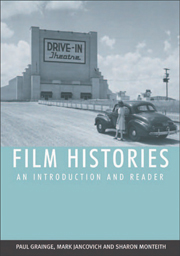Book contents
- Frontmatter
- Contents
- Preface
- Part I Film History from its Origins to 1945
- Part II Film History from 1946 to the Present
- 13 Postwar Challenges: National Regeneration, HUAC Investigations, Divestiture and Declining Audiences
- 14 The Politics of Polarisation: Affluence, Anxiety and the Cold War
- 15 Cinematic Spectacles and the Rise of the Independents
- 16 New Waves, Specialist Audiences and Adult Films
- 17 Radicalism, Revolution and Counter-Cinema
- 18 Modernism, Nostalgia and the Hollywood Renaissance
- 19 From Movie Brats to Movie Blockbusters
- 20 The Exhibitors Strike Back: Multiplexes, Video and the Rise of Home Cinema
- 21 Postmodernism, High Concept and Eighties Excess
- 22 Cults, Independents and ‘Guerrilla’ Filmmaking
- 23 From Cinemas to Theme Parks: Conglomeration, Synergy and Multimedia
- 24 Globalisation and the New Millennium
- Bibliography
- Copyright Acknowledgements
- Index
20 - The Exhibitors Strike Back: Multiplexes, Video and the Rise of Home Cinema
from Part II - Film History from 1946 to the Present
Published online by Cambridge University Press: 05 August 2013
- Frontmatter
- Contents
- Preface
- Part I Film History from its Origins to 1945
- Part II Film History from 1946 to the Present
- 13 Postwar Challenges: National Regeneration, HUAC Investigations, Divestiture and Declining Audiences
- 14 The Politics of Polarisation: Affluence, Anxiety and the Cold War
- 15 Cinematic Spectacles and the Rise of the Independents
- 16 New Waves, Specialist Audiences and Adult Films
- 17 Radicalism, Revolution and Counter-Cinema
- 18 Modernism, Nostalgia and the Hollywood Renaissance
- 19 From Movie Brats to Movie Blockbusters
- 20 The Exhibitors Strike Back: Multiplexes, Video and the Rise of Home Cinema
- 21 Postmodernism, High Concept and Eighties Excess
- 22 Cults, Independents and ‘Guerrilla’ Filmmaking
- 23 From Cinemas to Theme Parks: Conglomeration, Synergy and Multimedia
- 24 Globalisation and the New Millennium
- Bibliography
- Copyright Acknowledgements
- Index
Summary
After over a quarter of a century of declining audiences, the cinema of the 1980s saw not only the stabilisation of audience numbers, but also the creation of new audiences. One of the main reasons for this was the emergence of new forms of film exhibition. The late 1970s and early 1980s saw the emergence of home video as a new form of domestic technology. One use of the video was to time shift the viewing of television programming by taping its transmission and playing it back at another point. It also allowed the distribution of films on video that could be viewed in the home.
The studios initially reacted with horror at the technology, which was viewed as a major threat to cinema exhibition, but it was soon discovered that video reawakened interest in film in general and not only did cinema attendance start to grow once more but, by the mid-1980s, over half the revenue from feature film production came from video. In other words, just as the studios had previously operated the zone-run-clearance system, the contemporary film industry was able to use a video release to prolong the life of a film once it was played out at cinemas and hence it could continue to generate income from it. Indeed, since the mid-1980s, video has become even more important than the cinema financially (although it is being replaced by DVD) so that it is often claimed that cinema exhibition is no longer the key medium for Hollywood but now operates as a means of promoting the film prior to its release in other media.
- Type
- Chapter
- Information
- Film HistoriesAn Introduction and Reader, pp. 457 - 482Publisher: Edinburgh University PressPrint publication year: 2007



